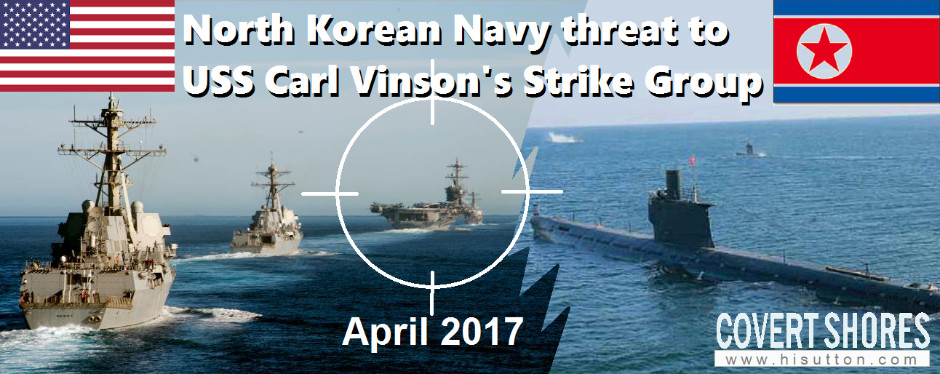
North Korean Navy threat to USS Carl Vinson's Strike Group

 In the immediate aftermath of the US cruise missile strike on Shayrat air base in Syria which was in response to the Assad government’s use of chemical weapons, the USS Carl Vinson is sailing back towards the Korean Peninsula. The Carrier Strike Group (CSG1) had been scheduled to visit Australia but has turned back towards Korea where it had been last month. The message for North Korea is that the same type of military action could be on the cards in response to their nuclear weapons program. The US Pacific Command described the deployment as ”a prudent measure to maintain readiness in the region.” President Trump has said the US is prepared to act alone to deal with the nuclear threat from North Korea.
In the immediate aftermath of the US cruise missile strike on Shayrat air base in Syria which was in response to the Assad government’s use of chemical weapons, the USS Carl Vinson is sailing back towards the Korean Peninsula. The Carrier Strike Group (CSG1) had been scheduled to visit Australia but has turned back towards Korea where it had been last month. The message for North Korea is that the same type of military action could be on the cards in response to their nuclear weapons program. The US Pacific Command described the deployment as ”a prudent measure to maintain readiness in the region.” President Trump has said the US is prepared to act alone to deal with the nuclear threat from North Korea.
North Koreasees the strike on Assad as proof that its nuclear ambitions are justified. Simply put, the presence of nuclear weapons deters Regime Change and similar policing actions: Saddam Hussein didn’t have them, Gadhafi didn’t, and Assad doesn’t. North Korea does. Only their state of development and whether they constitute an effective minimum deterrent yet that is open for debate.
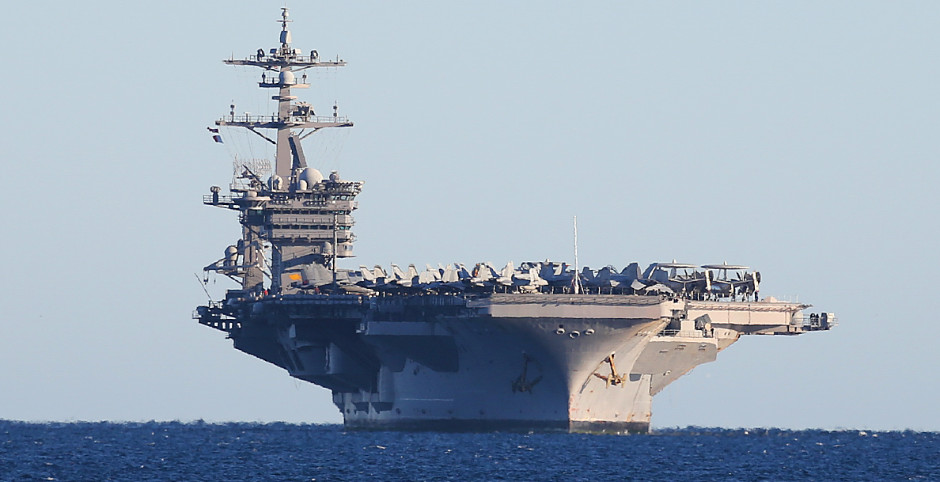
USS Carl Vinson CVN-70
If the USS Carl Vinson Strike Group launches at strike on North Korean nuclear infrastructure and development programs, it seems more likely that the North Koreans will fight back. This quick analysis will explore the potential threat that the North Korean Navy could pose to the battle group. Land and air based retaliation, including by artillery and nuclear frces, is beyond the scope. As are the merits of a US strike or a North Korean retaliation. This article therefore concentrates on what seems possible for the North Korean Navy. Challenges, analysis and corrections welcome.
Executive Summary
The North Korean Navy represents a minimal threat to the Carl Vinson Strike Group. However, they would competently and aggressively operated and there are some scenarios where they could the US Navy a bloody nose.
Analysis
The North Korean Naval threat can be divided into four topics:
- Submarines
- Surface-Effect Missile armed Fast Attack Craft (FACs)
- Larger warships
- Other Fast Attack Craft (FACs)
Reportedly, the Strike Group is currently consists of the carrier itself with its Super Hornet and Hornet fighters and at least three warships capable of carrying Tomahawk Cruise Missiles (two DDGs, one CG). There will be at least one submarine also possibly loaded with some cruise missiles. Therefore the Strike Group is able to launch prolonged offensive operations with both air strikes and cruise missile strikes. The US Navy has other strike assets in the region which could also be involved in any strikes.
The ultimate book of Special Forces subs Covert Shores 2nd Edition is the ONLY world history of naval Special Forces, their missions and their specialist vehicles. SEALs, SBS, COMSUBIN, Sh-13, Spetsnaz, Kampfschwimmers, Commando Hubert, 4RR and many more.
Check it out on Amazon
North Korea is only about 170 nautical miles across so cruise missile strikes could easily be launched from North Korea is only about 170 nautical miles across so cruise missile strikes could easily be launched from anywhere in the Sea of Japan, Yellow Sea of East China Sea (Tomahawks having an effective range of around 700-1,000 nautical miles depending on route planning, altitude etc). They could possibly be launched from a small area of the Western Pacific near to Japan although that seems less likely as they’d have to fly over Japan. Airstrikes with the carrier’s F/A-18 Hornets or Super Hornets are generally much shorter ranged, up to about 400 nautical miles. This still gives them large swaths of the Sea of Japan and Yellow Sea to operate from, and longer range missions would be possible with air-air refueling or other creative solutions.
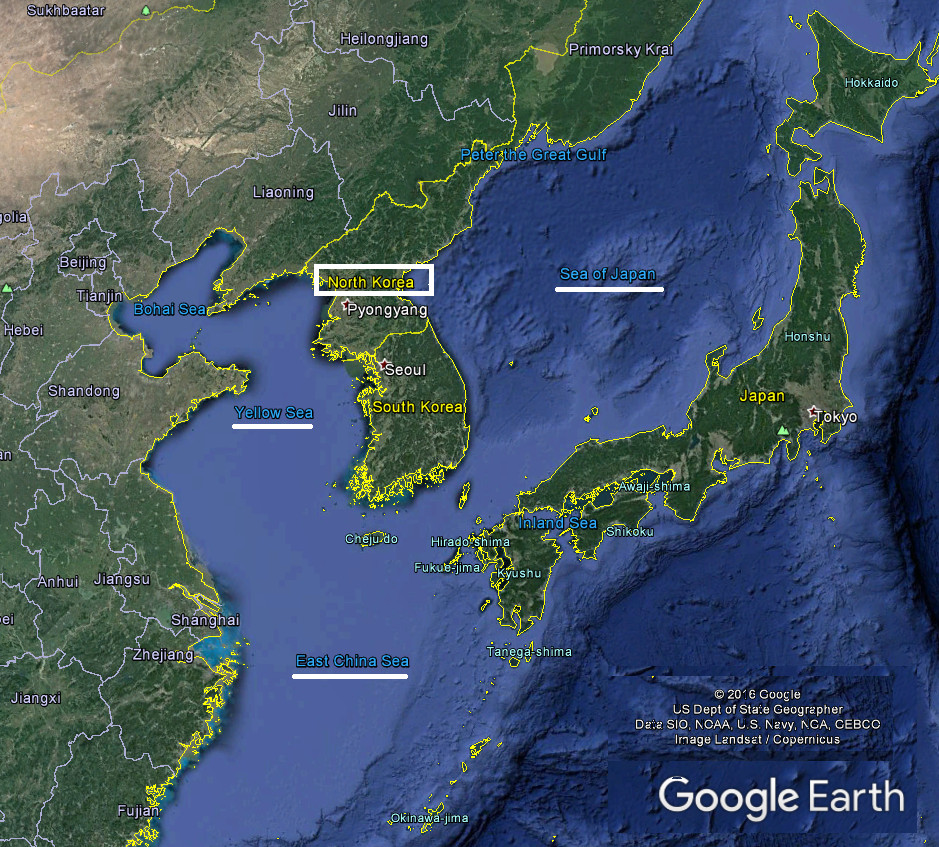
North Korean submarine threat
North Korea has the second or third largest submarine forces in the world with around 70 operational boats (main article). They are however mostly very old or very small:
Original artwork. CLICK for high-resolution image.
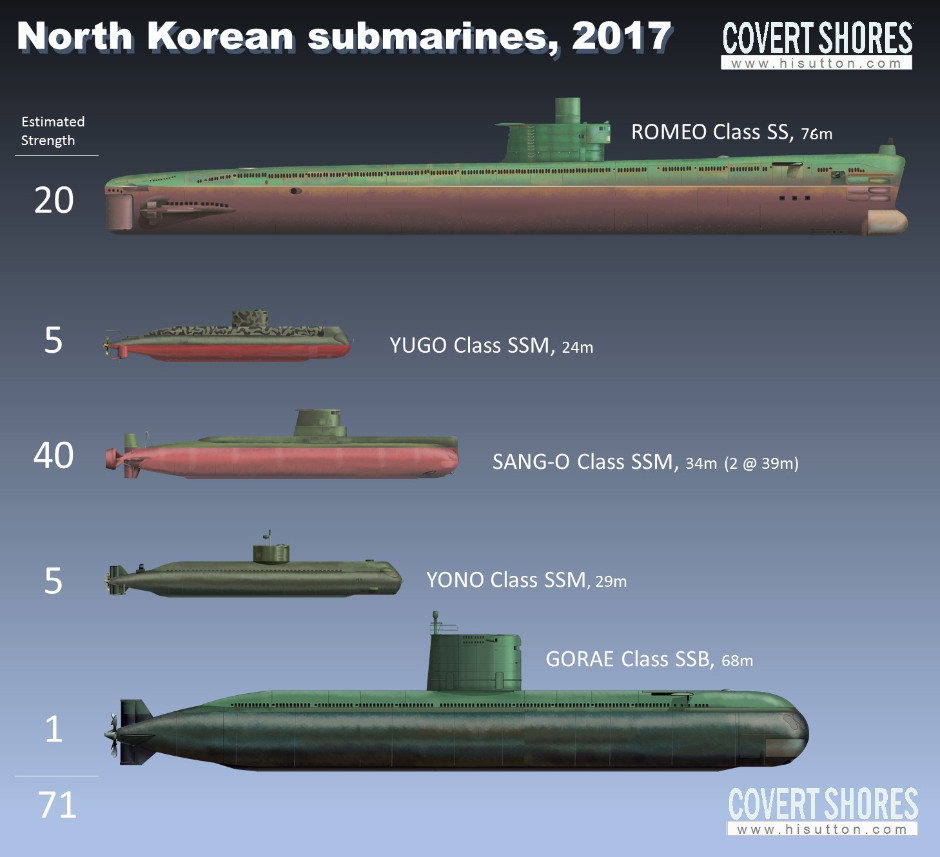
To the west of North Korea, the relatively confined Yellow Sea is very shallow with an average depth of just 44 m (144 ft) and a maximum depth of only 152 m (500 ft). It is also crowded with shipping and fishing vessels (mostly Chinese) trailing nets, so it is far from ideal submarine warfare conditions. On the east coast the Sea of Japan is much deeper with an average depth of some 1,752 m (5,748 ft) and a maximum depth of 3,742 m (12,277 ft). There are still a lot of fishing vessels but this is generally speaking more ideal for submarine warfare. The East China Sea is similar to the Yellow Sea.
Combined with the locations of some of the likely targets on the west coast, the USS Carl Vinson Strike Group seems most likely to operate from the Sea of Japan where their own submarines can be used to maximum effect. It could of course deploy to either coast, but the Yellow Sea also has the complication of being nearer to Chinese vessels.
Only the vintage ROMEO Class boats have the range to operate far out in the Sea of Japan or East China Sea. The threat from any submarine should never been underestimated, but these are very old and noisy boats with limited situational awareness. They are armed with effective but basic anti-ship torpedoes – anti-submarine torpedoes are less clear but unlikely to be advanced.
The ROMEOS are also too slow to outmaneuver the Carrier Strike Group. And once in deeper water they would be comparatively easy targets for US Navy nuclear powered attack submarines. Thus, while they are ideal for threating commercial traffic they are a relatively limited threat to the US Navy.
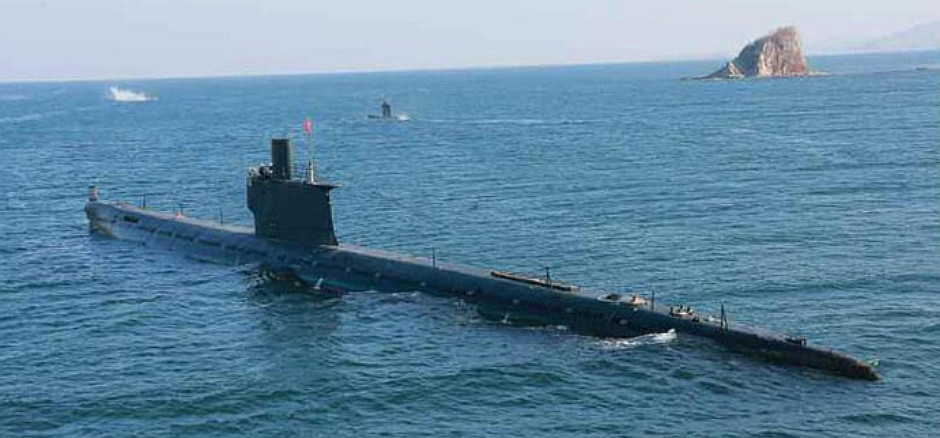
1950s era Soviet designed ROMEO Class submarine.
Closer inshore the fleet of SANG-O and YONO Class midget submarines would present a greater threat. But these are designed primarily to fight the South Koreans it seems and while they are a menace in the littorals, they are too short ranged and slow to be a serious threat in open water, particularly the Sea of Japan. Their range can be extended by towing behind a surface vessel but this is more applicable to offensive operations rather than defensive ones.
SANG-O Class Specification
Displacement: 277t surfaced, 370t submerged
Length: 35 meters
Beam: 3.8 meters
Height: 6.7 meters overall
Power: 1 diesel engine, 1 electric motor
Speed 7.2 knots surfaced, 8.8 knots submerged
Range: 1500 nautical miles
Max Depth: 150 meters
Crew: 15
Armament (attack sub): 2 x 533-mm torpedoes with no reloads
Armament (Special Forces /infiltration version): None. 5 infiltrators and 6 KWP Reconnaissance Bureau Cadre as passengers

The MS-29 YONO Class midget submarine is armed with two 533mm (21") heavyweight torpedoes. They are effective against slow moving ships but unclear against submarines or faster warships.
North Korea may hope that the Carrier Strike Group operates in shallow waters where its submarines stand the greatest chance. This is unlikely, but One scenario where they might prove effective would be if the Strike Group waited in the East China Sea where it is out of reach of almost all North Korean assets and yet able to respond immediately with Cruise Missiles, or dash into the Sea of Japan to deliver air strikes. In the latter case the Strike Group would have to move through the relatively shallow (140 m, 450 ft) and narrow (~100 nautical miles) Korea Strait between Korea and Japan. Given enough time the North Koreans could place enough ROMEO and SANG-O boats at the eastern end of the Korea Strait to pose a threat to the Strike Group as it comes through. But these boats would have limited combat persistence at this range (especially the smaller SANG-Os) so timing would be critical. And the South Korean and Japanese Navy’s are unlikely to watch passively if North Korean boats surge into this area.
An MS-29 YONO class boat is believed to have been responsible for the sinking of the South Korean corvette Cheonan in 2010. This demonstrates their inshore potential when assisted by the element of surprise, but does not easily translate into an open water threat.
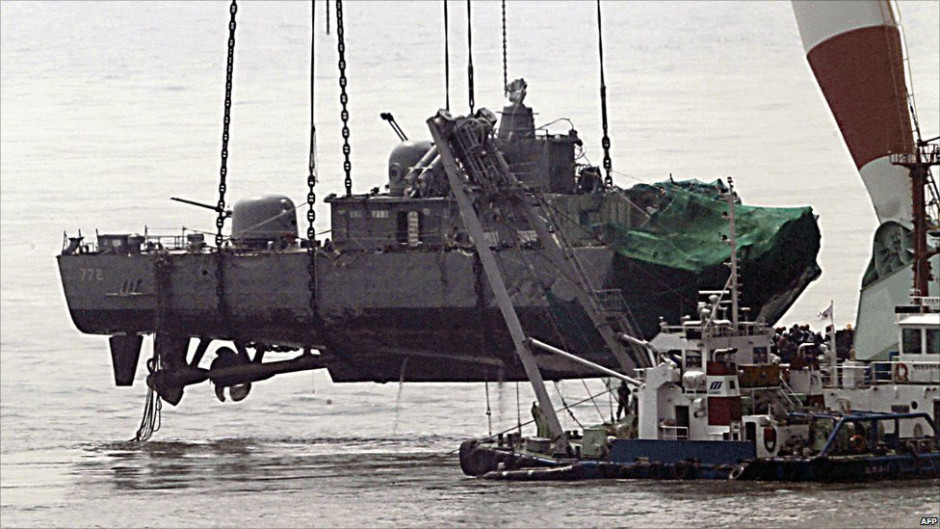
The aft section of the Cheonan being raised. This is a strong reminder that North Korean midget submarines can pose a real threat, but the attack was under very different operation conditions to an attack on the Carrier Strike Group.
Another possible area of operations for the North Korean submarines is near to the entrances of South Korean ports. If the US heightened presence is protracted, elements of the Carrier Strike Group or other US warships may pay port visited to South Korea. Although anti-submarine warfare would be stepped up, the shipping lanes to these ports would be home ground for North Korean planners.
North Korea also has a single GORAE Class (aka SINPO Class) ballistic missile submarine. Since this is still undergoing trials and would be one of the targets for the US strike, it is likely to put to sea to hide. It is thus a limited threat.
However, if the North Korean nuclear program is more progressed than believed, the GORAE missile submarine could be used to deliver a single nuclear armed ballistic missile to South Korea or Japan. This seems improbable.
 Main article
Main article
Surface-Effect Missile armed Fast Attack Craft threat
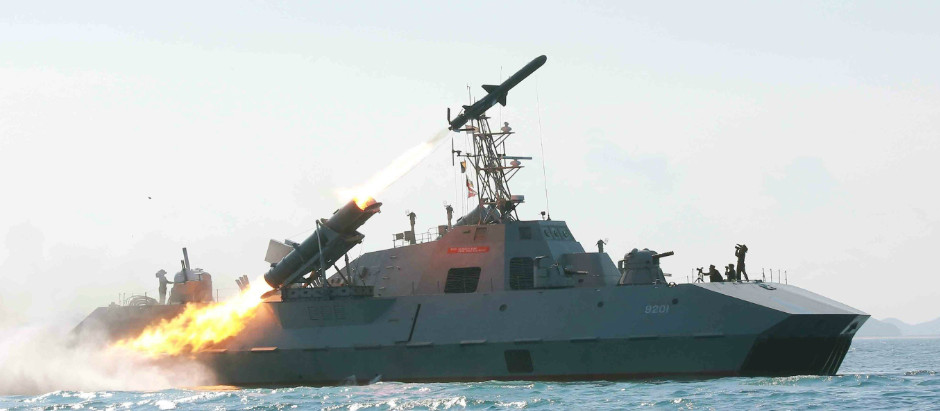
A Nongo Class Surface-Effect-Ship launches a Kh-35E anti-ship missile.
Since the early 2000s North Korea has been slowly building a fleet of relatively modern Surface-Effect-Ships (SES). An SES combines the features of a catamaran with the skirt and lift fans of a hovercraft. They are generally capable of very high speeds and represent difficult targets. Equipment standards vary from boat to boat but some of are equipped with Russian designed Kh-35E anti-ship missiles (reported as KN-09, possibly locally produced) which are approximately equivalent to the Harpoon.
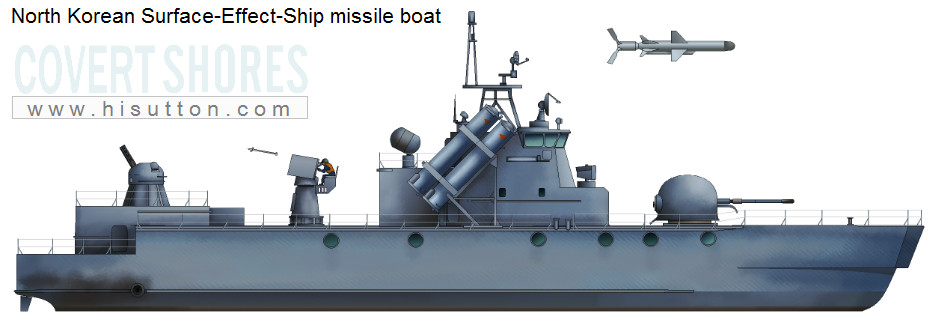
A non-stealthy design based on the West Coast. It is equipped with up to eight anti-ship missiles.
There are two main variants, both of which are likely to be operational on both coasts in small numbers. The first is a moderately stealthy design with four Kh-35E in semi-retractable launchers, and the second is a non-stealthy version with eight Kh-35E. Both versions have a 6-round MANPADS launcher and a variety of locally designed 30mm anti-aircraft guns. The non-stealthy version also has a 76mm automatic cannon based on the Italian OTO-Melara compact.
The SES are designed for inshore operations although they could venture out into the middle of the Sea of Japan or Yellow Sea. Because North Korea lacks over-the-horizon targeting (although intelligence could be provided by fishing vessels), the Kh-35E’s range is likely to be about 30 nautical miles depending on the size of the target. These missiles are unlikely to sink an aircraft carrier but they could do damage. Combined with the SES boat’s high speed they could pose a serious threat if unchallenged. However, their air defense and electronic warfare capabilities are likely to be very poor, making them relatively easy pray for a watchful US Navy.
Larger warship threat
The North Korean Navy is a brown water Navy, but they have maintained a strictly limited and intermittent green-water capability, primarily in the form or light frigates. These serve as flagships and, in peacetime could be used to escort ships involved in missile testing.
The backbone of this force is two old Najin Class light frigates which have recently been moderately upgraded and can now Kh-35E anti-ship missiles. One ds based on each coast and they could attempt to engage the Carrier Strike Group, but would be relatively exposed with little if any escorts, poor air defenses and no air cover.
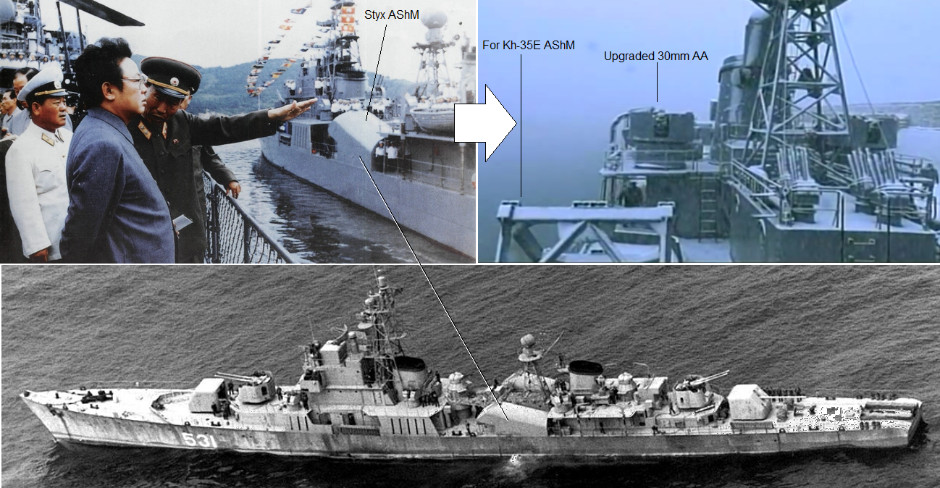
Najin Class light frigate, showing evidence of weapons upgrade
North Korea is also building a new group of light frigates which incorporate some signature reduction methods. Two are being built on each coast and they may replace the Najin (and retired Soho Class) when they enter service.

An unfinished light frigate seen in Najin on the East Coast in November 2016.
These will feature 76mm autocannons and presumably 8 x Kh-35E anti-ship missiles. Construction has been slow, starting in around 2012, and the design was changed mid-construction. As originally planned they featured a large helipad at the stern but this has been removed and air defense systems added instead. None of the vessels appears operational at this time.
A recent tourist snap unintentionally revealed both east coast light frigates based at Najin near the Russian border:
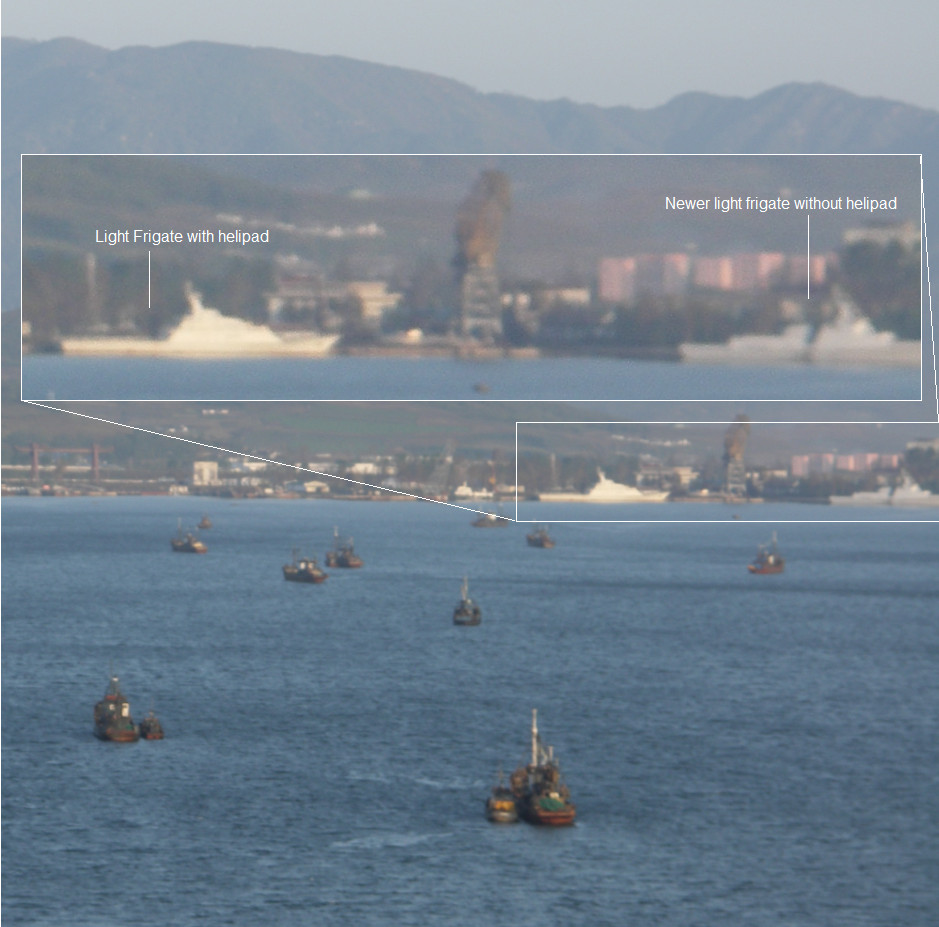
One of the east coast examples still has the helipad.
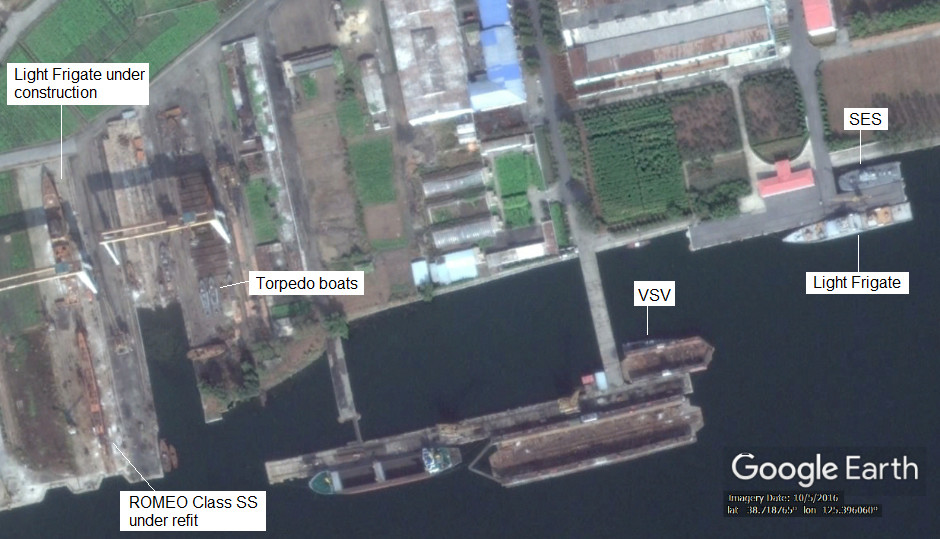
Light frigates and other types in Nampo on the west coast.
The individual ships do not appear identical, but they are of the same family:
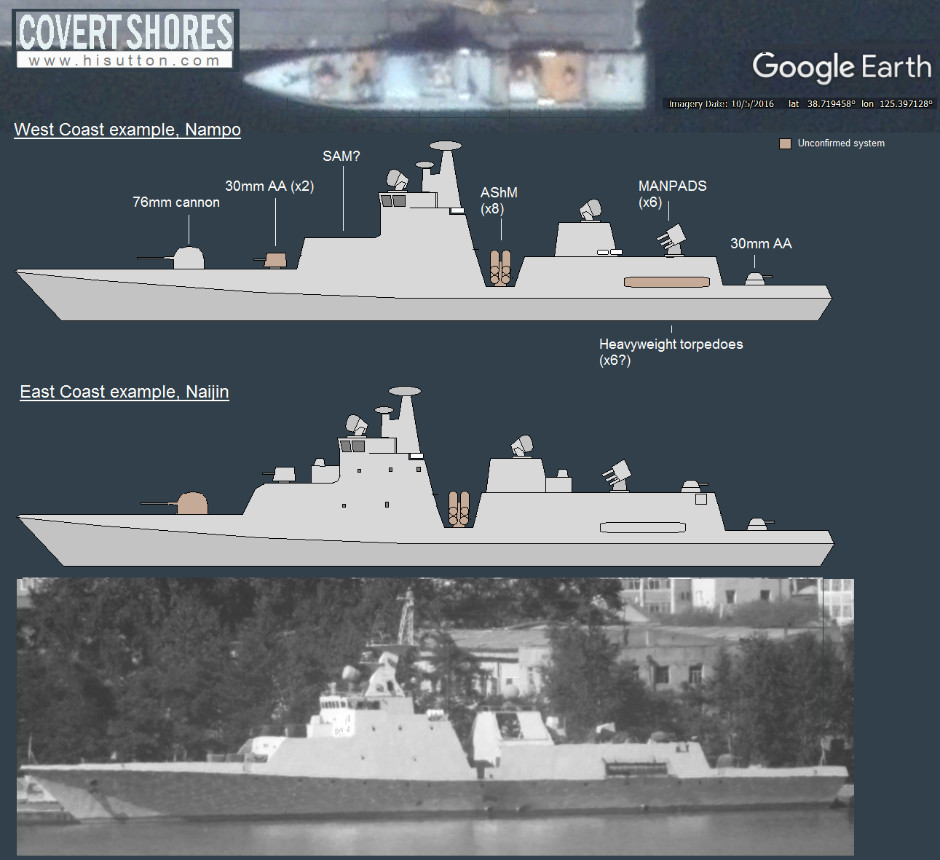
Other Fast Attack Craft (FAC) threat

The most interesting North Korean fast attack craft (FAC) project is the Very Slender Vessel (VSV) program. These steel boats should have excellent sea keeping making them more of a threat than other non-missile-equipped FACs. However, they are not equipped with missiles so even if they can approach the US forces they have only limited means to do damage – their MLRS are very powerful but too short ranged to fight with a Destroyer.
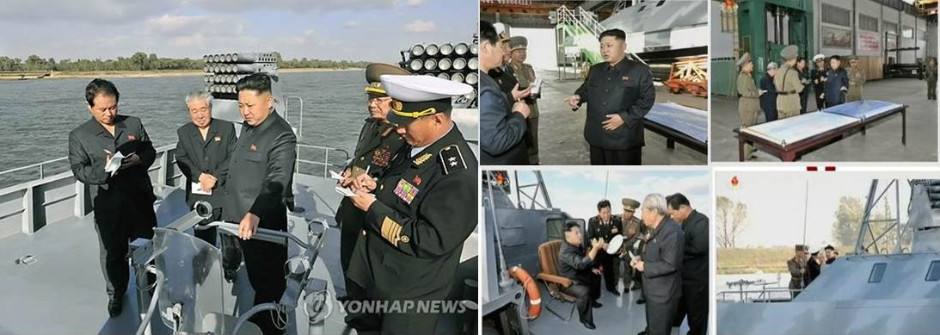
Video captures of Dear Leader giving guidence on VSVs, from bemil.chosun.com -very good source (in Korean)
VSV Specifications (Largest type)
Length: 32-34m
Beam: ~5m
Speed: 50kt (reported)
Armament: 2 x torpedo tubes, 3 x 24 MLRS, 1 x 2 MANPADS
 main article on Very Slender Vessels (VSVs)
main article on Very Slender Vessels (VSVs)
North Korea has a large fleet of old missile boats (Styx missiles) and torpedo boats which, due to their numbers, could be a menace inshore. But these are sorely dated and do not have the sea keeping to offer much threat to the Carrier Strike Group except in favorable conditions.

